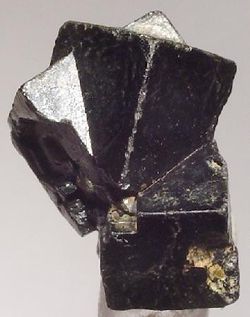| Thorianite | |
|---|---|
 Group of interpenetrating twinned thorianite crystals from Ambatofotsy, Madagascar (size: 1.6 x 1.4 x 1.3 cm) | |
| General | |
| Category | Oxide mineral |
| Formula | Thorium oxide, ThO2 |
| IMA symbol | Tho [1] |
| Strunz classification | 4.DL.05 |
| Crystal system | Isometric |
| Crystal class | Hexoctahedral (m3m) H-M symbol: (4/m 3 2/m) |
| Space group | Fm3m |
| Unit cell | a = 5.595 Å; Z = 4 |
| Identification | |
| Color | Dark gray, brown-black |
| Crystal habit | Cubic crystals, usually rounded to some degree in detrital deposits |
| Twinning | Penetration twins on {111} common |
| Cleavage | Poor/Indistinct |
| Fracture | Irregular to uneven, sub-conchoidal |
| Mohs scale hardness | 6.5 – 7 |
| Luster | Resinous, sub-metallic |
| Streak | Grey, grey green to black |
| Diaphaneity | Opaque, translucent on thin edges |
| Specific gravity | 9.7 |
| Optical properties | Isotropic |
| Refractive index | n = 2.20 – 2.35 |
| Other characteristics | |
| References | [2] [3] [4] |
Thorianite is a rare thorium oxide mineral, ThO2. [5] It was originally described by Ananda Coomaraswamy in 1904 as uraninite, [6] but recognized as a new species by Wyndham R. Dunstan. [7] It was so named by Dunstan on account of its high percentage of thorium; it also contains the oxides of uranium, lanthanum, cerium, praseodymium and neodymium. Helium is present, and the mineral is slightly less radioactive than pitchblende, [8] but is harder to shield due to its high energy gamma rays. It is common in the alluvial gem-gravels of Sri Lanka, where it occurs mostly as water worn, small, heavy, black, cubic crystals. The largest crystals are usually near 1.5 cm. Larger crystals, up to 6 cm (2.4 in), have been reported from Madagascar.